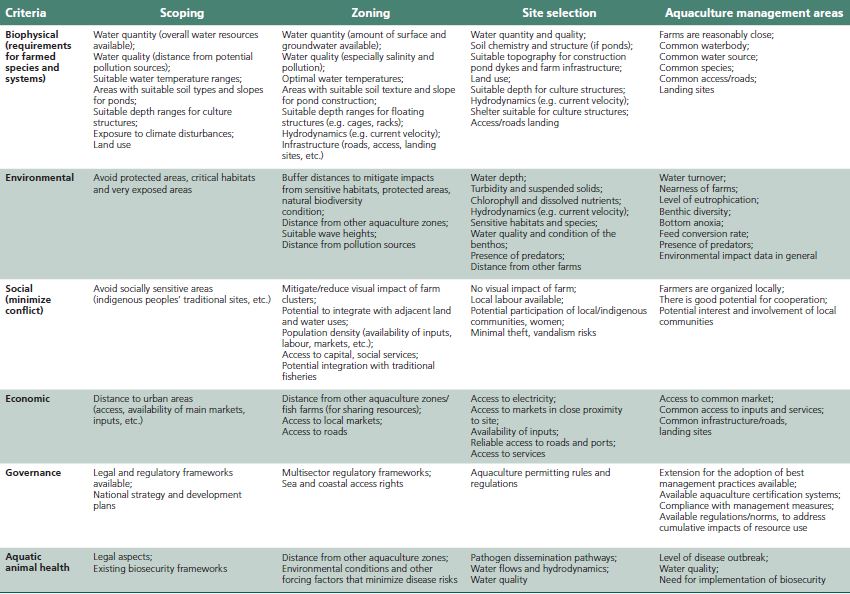4.2. Identification of issues and risks in zoning
There are a broad range of issues and risks for zoning, and it is advisable to identify, inter alia, those related to environment, biosecurity, climate-related risks, social conflicts and governance. A good approach to identify issues is to focus on the different steps in the aquaculture production process, including upstream (e.g. feed supply) and downstream (e.g. post-harvest) aspects, and understand the impacts on such processes and the likelihood of occurrence. By doing this, it should be possible to determine whether the risk and likelihood of occurrence means a specific zone is unsuitable to become an aquaculture zone.
Aquaculture as a production process may require land/sea area as well as water and specific inputs, including labour, to produce expected outputs such as food and income together with unwanted outputs such as nutrients or chemicals. Issues need to be identified within a specific scale and ecosystem boundary, so risks can be defined as local only, or regional, or national. Tranboundary issues should also be addressed where, for example (rivers), water starts within one country, but flows through another and then used for aquaculture development. The converse is also true when water, potentially impacted by nutrients from aquaculture, flows across borders into another country or region.
In most cases, issues such as climate change impacts and urban pollution of aquatic environments have damaging effects on aquaculture. Aquaculture is vulnerable to a number of potentially catastrophic climatic and other disturbances. In addition to wildlife (especially bird) predation, disease and theft, which affect all aquaculture systems, there are likely to be risks that apply only to specific production systems and zone location, such as:
Risks specific for pond/raceway aquaculture:
• floods
• droughts
• severe winters
• earthquakes
• volcanic eruptions
• tidal surges/storm surges/tsunamis
TABLE 7. Essential criteria for scoping, zoning, site selection and aquaculture management areas. Depending upon the species and systems being considered for aquaculture, other criteria deserve consideration

Risks specific to cage aquaculture include:
• oil spills/chemical spills/chemical runoff
• pollution
• superchill/ice
• storms
• harmful algal blooms and jellyfish
• hypoxia
In addition to these biophysical risks, conflicts with other natural resource users are common. Chief among these are the direct competition for water and space with agriculture and real estate developers; access to traditional sites of indigenous people; and disagreements over visual impact with the tourism sector. Conflict with fishers is also common, given that sea space or lake space can become off limits when structures such as cages are added, which reduces the ability of fishers to exploit such areas.
Risk analysis involves answering the following questions (Bondad-Reantaso, Arthur and Subasinghe, 2008): (i) What can go wrong? How likely is it to go wrong and what are the consequence of its going wrong? and (ii) What can be done to reduce either the likelihood or the consequences of its going wrong?
Risk mapping can help to identify the most important threats. Examples of risk maps for aquaculture zoning include:
• Fish cage farming and tourism. Use of GIS-based models for integrating and developing marine fish cages within the tourism industry in Tenerife, Canary Islands (Pérez, Telfer and Ross, 2003a).
• Islands and wave strength. Climate-related wave risk maps for offshore cage culture site selection in Tenerife, Canary Islands (Pérez, Telfer and Ross, 2003b)
• Floods and aquaculture. Modelling the flood cycle, aquaculture development potential and risk using MODIS data: a case study for the floodplain of the Rio Paraná, Argentina (Handisyde et al., 2014).
• Monitoring algal bloom development.
Environmental information system using remote sensing data and modelling to provide advanced warning of potentially harmful algal blooms in Chile so that their impacts can be minimized by the aquaculture industry (Stockwell et al., 2006).
It is also important to assess the environmental and socio-economic risks that aquaculture can pose to other sectors and on itself. These may include biodiversity losses due to organic and chemical pollution, diseases generated by fish farms, and impacts from escaped fish. These risks are evaluated and mitigated through a solid understanding and management of a zone, or AMA location, and carrying capacity. For large industrial farms (e.g. salmon cages), there are models to estimate the spatial distribution of organic matter and related risks and the consequences in terms of water quality and overall carrying capacity (see section 4.3 and Annex 4).